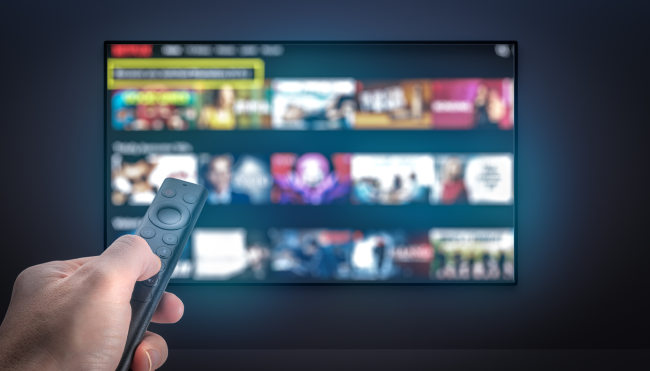- Why Amagi
-
Solutions
Contact UsBusinessWho We Serve
- Offerings
- AI
-
Resources
Contact UsINDUSTRY REPORTSAmagi FAST Report #15: The Power of Live Programming: A Catalyst for Streaming SuccessAugust 21, 2025Read More
-
Company
Contact UsNewsroomAmagi launches AI-powered Smart Scheduler to improve content programmingApril 3, 2025Read More
Blog
State of the TV Industry with Srini, Co-founder, Amagi
By Amagi - June 5, 2020
Five Questions for Srini, Co-founder, Amagi
As an industry player, what are the big trends in TV that you see?
I see a fundamental shift in TV viewing habits happening, further accelerated by the pandemic now. A few large trends, apart from the broader shift to Streaming TV from linear broadcast:
- Connected TV devices are growing at a rapid pace. As per reports, by 2023, connected TV households will be 83% of all households in US. This is a massive shift
- Advertising is shifting from traditional TV to streaming TV –advertising grew by 330% in 2019 according to a recent report
- Shift to cloud – we are seeing a large scale migration across M&E sector towards cloud as the industry prepares itself to be agile in these changing circumstances.
How is the industry responding to these developments?
At the outset, we see two distinct segments in the TV industry emerging today – Broadcast TV and Streaming TV. As consumers shift from traditional cable subscriptions to new-age over-the-top streaming models, we are seeing many of the broadcast TV networks creating OTT offerings to stay relevant in the marketplace. Large content studios are seizing the opportunity and launching their own streaming platforms banking on their large content libraries. Content aggregators and video service providers are innovating on various business models – subscription-based, ad-supported, hybrid models with tiered content offering. Similarly traditional TV advertising is quickly moving into the programmatic way. I believe, one of the biggest trend we will see is in the Connected TV space. As Connected TV providers already have market penetration, they have a huge opportunity to generate continuous revenue by offering programming as well.
Why are we seeing a demand for live channels on streaming TV? Isn’t streaming largely an on-demand territory?
As I said earlier, streaming is the new TV. When we see content creation being democratized, it brings about an abundance in content availability. Discovering content has always been a challenge for viewers. Even on video-on-demand platforms, content recommendation engines are in play. It’s hardly surprising that many viewers aren’t fully aware of all the program titles available on the platforms they follow. Added to that, the complexity of choice as one subscribes to multiple platforms leading to a subscription fatigue. To free oneself from the burden of having to discover and watch content, viewers are warming up to the idea of content being available as part of a channel EPG. As a result, linear channels are increasingly becoming attractive to viewers. To expect TV-like viewing experience while streaming is becoming a norm. Hence, a growing demand for linear content on streaming TV!
Will advertising shift from broadcast TV to streaming TV? Won’t viewers prefer ad-free, subscription-based streaming models?
Realistically, you can’t expect every household to subscribe to multiple streaming platforms. At best, one will have some sort of a cable TV subscription and add a couple of streaming TV subscriptions to their entertainment budget. In some cases, we may see a complete cord-cutting. In any case, I don’t see an average household investing in more than five platform subscriptions at any given time. Now that we have several big studios and networks with their vast libraries vying to get a share of this pie, we will see consolidation in the industry. This means that top 3-5 subscription platforms will eventually capture most of the market, but make enough room in the market for ad-supported models to co-exist. This will include those platforms that offer a hybrid model as well. In the ad-supported streaming TV model, advertisers will be able to segment audiences more granularly and leverage higher number of ad impressions. This makes advertising on streaming TV platforms more flexible, cost-effective, and measurable. We expect to see advertising budgets shift to streaming TV in the range of US$200-$250 billion in a year, and grow at higher percentage levels in the years to come.
What according to you is the impact of COVID-19 pandemic on the streaming TV industry?
It’s obvious that owing to lockdown restrictions in many countries around the world, people are staying within the confines of their home without access to different forms of entertainment which they are generally accustomed to. As a result, we are witnessing a huge spike in streaming TV consumption. This pandemic with extended restrictions is changing our outlook towards life, and has brought in new habits, a different lifestyle, and affected our disposable incomes and so much more. It has impacted us in several ways – the way we watch TV is certainly one. I think the pandemic will accelerate adoption of streaming TV as people have been exposed to newer content experiences. I also believe, given the financial implications, ad-supported streaming models will come out much stronger from these times. We do see a dip in overall advertising as we live in a world of interconnected economies. But, this dip is for the short-term. The big picture we must appreciate is that overall TV viewing habits are impacted, and it will put some of the inevitable changes on a fast-track.
Related Blogs
Get started
Increase revenue and reach with our Broadcast & Streaming solutions.
Cloud modernization. Streaming unification. Monetization. Marketplace.
 German
German French
French Spanish
Spanish Korean
Korean Japanese
Japanese Portuguese
Portuguese


